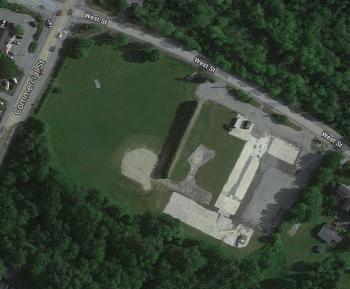Rockport group mulls over development possibilities of former elementary school site
ROCKPORT — In May, Rockport residents may be invited to a workshop seeking feedback on the potential development of the the now vacant 7 acre lot on the corner of Routes 1 and 90, and on which the Rockport Elementary School once stood.
The RES Committee met March 27 to discuss multi-use options for property. The committee invited realtor Martin Cates to attend the meeting, and sought feedback from him regarding concepts to develop the site, concepts that include creating office and retail space there, as well as residential housing.
The seven acre property is owned by the Town of Rockport. Since the demolition of the school in 2013, the site now consists of some concrete slabs but is primarily grass and green space, which has served, in part, as a baseball field throughout the years.
Although sited at a busy intersection, he property is within close proximity to the Camden Hills Regional High School and the Camden-Rockport Elementary School, as well as Rockport Harbor and residential Pascal Avenue.
Committee members present at the March 27 meeting, held at the Rockport Town Office and not streamed live, included Debra Hall and Doug Cole of the Select Board, Town Manager Rick Bates, Town Planner Bill Najpaeur, Administrative Assistant for Assessing, Codes and Planning Hannah Sisk, as well as Planning Board member Clark Dolan.
The informal committee’s goal is to pursue a project that would develop the space to contribute to the town’s tax base while being aesthetically pleasing to residents and tourists.
The committee’s other principles of development include that green space is “maintained, incorporated and nurtured” and that “decisions are not simply ones of ‘dollars and cents,’ but that they take into account the shared values of all the citizens of the town and their visions for it.”
Cates was shown two renderings of potential development plans for the site, as well as a draft of a RFP (request for proposals) to be sent to developers.
The site plans include buildings that feature retail and office space on the ground floors and housing above; the committee said the structures could be two or three stories high.
The renderings also explored using portions of the property for recreational space and building a pond on the site.
During the meeting, the committee discussed the idea of having a pavilion area, which would serve as a year-round market or crafts space. With their tenet of a mixed use development of “prime real estate in Rockport,” Cates was asked how the plan could be the most viable.
“A mixed-use option is the broadest way to appeal to the widest interest... the property is highly highly visible,” said Cates, but warned that raising community expectations without immediately acting can be devastating.
He cited similar projects in the area, such as Tannery Park, in Camden, and the Thomaston Green, as examples. Cates said that Thompson’s Point, in Portland, was an example of a success because it offers events and attractions throughout the year.
Cates stressed to the committee the importance of having a concept that would attract investors or potential developers, as well as seeking input from residents and conducting a community analysis – asking townspeople how they envisioned the site being used.
He said that the property would appeal to investors because of its location, and that ideally it could provide both millennials and retirees with housing located near amenities.
The property cannot be sold to developers without a vote by the town.
Cates also recommended that to make the property more attractive to investors, infrastructure work should be completed beforehand, such as adding running sewer and water lines to the site. Cole and Bates discussed if the town’s TIF (tax increment financing) district could be expanded to include the property in upcoming sewer work in the area.
“Find a developer who is willing to sit down and talk to you,” said Cates when asked by the committee how to move the project forward. “Make face-to-face contact with them, and find out what is important to them. How much are townspeople invested in your four principles for the project? Find this out early on in the process so any movement forward can be made.”
For the remainder of the meeting the committee discussed holding a public forum in May that would include residents to express their vision of the site’s future use.
Some concepts for this meeting included providing citizens with tax maps of the site and asking them to depict with to-scale buildings, etc., their imaginings of the property.
The next meeting of the RES Committee will be held Wednesday, April 17 at 1:30 p.m. at the Rockport Town Office.



























